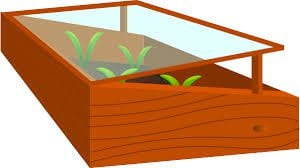If you are like me – and the majority of the people I know who live in Grey County – you’re smack dab in the middle of vegetable garden season. And if you’ve got some knowledge, hard work and a little luck you’re starting to enjoy the results of the sweat equity you put into your garden 6-8 weeks ago. One thing I’ve noticed about successful gardeners is that they never stop working on their gardens and they never stop gathering tidbits of useful information that they can put to the test to see if they can improve upon the previous year’s results. A garden, whether it be full of fruit, flowers, veggies or a combination of all three, is nothing if not a work in progress! In that spirit, here are some tips that I’ve come across this spring and summer. I hope you find a helpful suggestion, a new idea to try or something that helps you achieve success in your own garden this year.
Inter-planting: If you don’t have a lot of space for a vegetable garden or are eager to try out a few different plants during our relatively short growing season, inter-planting might be the way to go. The idea is to grow two or more types of vegetables in the same space. You might try spacing out your tomato plants so that you can tuck some radishes in between them, for example, or maybe interspersing a quick growing lettuce with a slow growing cabbage. Doing a little research to make sure your plants are compatible goes a long way. You need to take into account things like time to maturity and preferred growing season (pair short lived plants with longer lived ones), eventual size and where that growth will happen (above ground or underground), plant family and possible incompatibility (ideally you don’t want to fill an area with members of the same family, or with plants that can cause growth problems for their neighbours). Once you’ve got your information, how and what you plant is up to you. Alternate with every plant or row by row. Just remember to give your plants the room they need and avoid overcrowding.
Plant in Succession: One of the problems many of us have is that because we’ve planted most of our seeds or seedlings at the same time, everything ripens at once and must be eaten immediately, given away or preserved so that it doesn’t end up rotting in the fridge. A good way to avoid this scenario is to plant in succession. If you’re putting beans in your garden, for example, plant one row every two weeks over a period of time. This also gives you the opportunity to try a different variety with every planting, if you like and reduces the likelihood that you’ll lose our whole crop to a late frost or some other hazard. Another way to approach this would be to switch up your crop entirely. For example, when your early peas are finished, replace them with a warm weather vegetable such as eggplant or peppers. If you do decide to plant immediately after sowing, make sure you remember to add compost and nutrients to replenish your soil.
Try a Cold Frame: Years ago (before we were jaded country-dwellers) we had a small cold frame at the back of the house. This was nothing more than a small hole dug close to the back wall of the house (in full sun), which was built up with some left over bricks and topped off with an old window. The sun warmed the ground that was close to the house, and the bricks held in that heat. The old window allows the cold frame to act as a mini-greenhouse…the perfect place to start your seedlings or extend your growing season when nightly frost is a concern. You can make your cold frame as intricate or as simple as you want. Ours was just a spot to place pots but you could make it a full-blown mini-garden, if you’re keen. Consider making your back wall slightly higher than the front so that condensation and rain can easily run off and ventilation is important, so don’t forget to prop a rock under the glass in order to allow fresh air to circulate.






